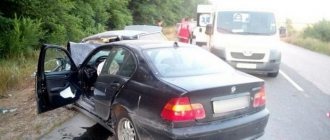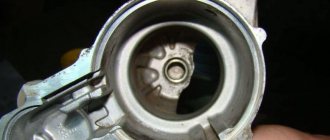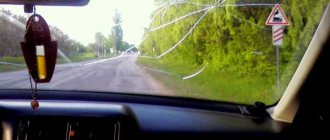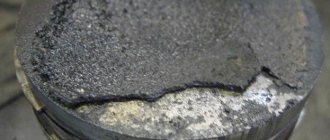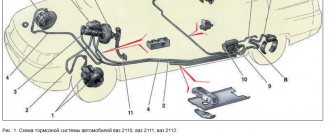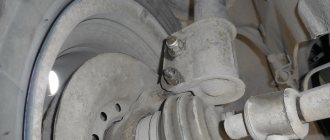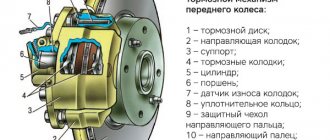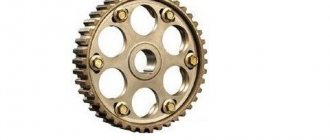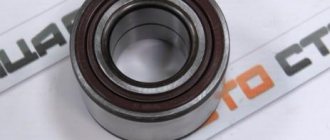The lion's share of road accidents occurs due to the fault of those who do not know how to brake correctly at traffic lights, intersections and other difficult areas. It is easier for an experienced driver to navigate than for a novice, but even he does not always have time to complete the necessary maneuver on time. Before heading to areas with heavy traffic, we recommend that you familiarize yourself with the theory and practice on the racetracks. Not only the safety of all road users, but also the condition of the car depends on braking technique.
Main types of braking
The braking method directly depends on the type of gearbox in the car. The easiest way to do this with an automatic transmission is to gently press the brake pedal until you come to a complete stop. If there are problems with the braking system or you are driving down a steep slope, then it is more advisable to use engine braking. To do this, use the S, L modes and the Hold button. The situation is completely different with a manual transmission. It is, in principle, more difficult to control, and therefore has some features when braking.
There are two main types of speed reduction:
- regular - under typical conditions, not requiring haste;
- emergency - due to a sudden obstacle.
Only standard braking can be safe and effective, and therefore requires unquestioning adherence to the rules. Emergency does not allow you to choose a method of stopping and calculate the braking distance, but with proper actions it helps save the lives of yourself and other road users.
Prohibited or allowed
The maneuver itself is dangerous, so it must be used with extreme caution. It is important to familiarize yourself in advance with all the specifics of its application and various nuances. All of these should be worked out in advance.
This is the only way to avoid problems and serious accidents. It is allowed to use maneuvers only in circumstances where it is really necessary. For example, to avoid injuries, road accidents.
Otherwise the driving will be identified as dangerous. Therefore, it will be necessary to familiarize yourself with all the subtleties and nuances in advance - otherwise, traffic police officers can simply impose a fairly serious fine on the driver.
Relatively recently, a new violation appeared in the Code of Administrative Offenses, which implies a fine for committing unpredictable and dangerous actions on the roads.
It is important for the driver to monitor the technical condition of his own vehicle. Because this is the only way to prevent standard mistakes that often occur.
Often it may simply not be possible to stop on time. For example, if the brake systems are in poor condition.
It is important to monitor the pressure in the hydraulic system, as well as the condition of the vehicle's pads. Today, many service stations simply sell diagnostic cards. And the cars are in fact in disrepair.
This is precisely the main cause of serious problems. There are various situations that require emergency measures when stopping. It is important to read them all carefully.
Standard braking
Stopping in a certain place without accompanying circumstances that would require sudden braking is called normal. On cars with a manual transmission, braking correctly with the engine is convenient, easy and economical. With regular use of the method, you can significantly benefit from fuel. When the place of the intended stop appears in sight, all you need to do is, without touching the clutch, smoothly release the gas. It doesn’t matter what gear is engaged when the tachometer needle drops to 40 km/h.
The engine stops the main work, prevents further rotation of the wheels and naturally slows down the movement of the machine. If nothing else is done, as a result of this type of braking the engine will stall. To prevent this from happening, you need to do the following:
- depress the clutch;
- move the manual transmission handle to the neutral position;
- Smoothly press the brake pedal.
There is another option in which you don’t need to wait for the idle speed to change gears down yourself. In this case, braking will occur even faster, and you most likely will not have to apply additional brakes. This method is only suitable for drivers with extensive experience. Beginners will inevitably encounter sharp jolts when changing gears - this is not only uncomfortable, but also harmful to the car itself.
Steering when skidding
As you have just seen, the driver cannot do without reasonable steering. The time has come to talk about this component of the fight against the beginning of a skid.
Where do you think the car will go when the skidding stops?
That’s right, where the front wheels are pointing, that’s where the car will go – to the right into the bushes (Fig. 56 a)! This means that when the car is skidding, it is not enough to work only with the gas pedal; it does not hurt to also work with your head.
Rice. 56. The exit of their skid: a) without taxiing; b) with steering
If you just sit while skidding, clinging to the steering wheel, then, having stopped sliding, the car will definitely go in the direction in which its front wheels will be directed. Therefore, at the moment the skid stops, the front wheels of the car should be directed in the direction where we are going to continue moving.
There is a well-known expression “turn the steering wheel towards the skid”. It clearly reflects the essence of the driver’s necessary actions to get out of a skid safely. Only sometimes, for some reason, it is difficult to immediately realize whether you should turn the steering wheel to the right or to the left. Therefore, let’s formulate this rule a little differently:
When a skid begins, turn the steering wheel towards the trunk of your car.
If you feel in time which side the trunk of your car is trying to “overtake” you and turn the steering wheel towards it, then the front wheels will always be directed to continue the safe trajectory (Fig. 56 b).
As a result of competent actions by the driver, the skid stops, and the rear wheels of the car begin to line up after the front ones. And here, as a rule, another problem arises.
If you keep the steering wheel turned to the left, then, returning to its place, the rear part of the car can, by inertia, “fly” over the longitudinal axis of the direction of movement, and then the skid begins again, but now in the other direction (Fig. 57)!
Rice. 57. The driver “overexerted” the steering wheel
Is it possible to avoid re-skidding?
Yes, you can if you use the “advanced influence on the steering wheel”.
This expression means that you should return the front wheels to the straight-ahead position a little earlier than the rear wheels return to their place. To do this, you will have to constantly monitor the position of the trunk of your car. As soon as the rear wheels stop sliding and the trunk “freezes” at the extreme point of deviation from the trajectory of movement (Fig. 57, item 3), you should immediately start turning the steering wheel back. Moreover, the “return” of the steering wheel should be slightly ahead of the “return” of the trunk. Otherwise, the car will continue to “wiggle its back” until some pillar stops this “dancing on the road.”
Of course, not everyone manages to feel the moment when they need to start turning the steering wheel back the first time. Therefore, we will assume that the trunk of your car nevertheless “flew” to the other side (Fig. 57, item 4) and now you have to fight against repeated skidding.
If you don’t panic and continue to maintain composure, then it won’t be difficult to “defeat” a repeated skid. This time the trunk will not move as far away from the trajectory as before. Therefore, by repeating competent steering, first in the direction of the new skid (to the right), and then with a proactive action in the opposite direction (to the left), you can easily align the rear wheels after the front ones.
Anticipatory action of the steering wheel allows you to avoid repeated skidding of the car.
Combined braking on a car
Combined braking involves a combination of stopping the engine slowly and applying the brake. Thanks to the engaged gear, the wheels will not lock up during a maneuver, which means the car will always be under the control of the driver. The car will brake faster, more efficiently and safer than using one brake pedal and the clutch depressed.
It is best to use combined braking when the distance to the obstacle is short, as stopping will occur faster. The procedure is simple:
- Take your foot off the gas pedal and gently press the clutch.
- After releasing the gas, begin to gradually depress the brake pedal.
- When reaching idle, engage the clutch, move the manual transmission to neutral, and stop the car.
As in the case of normal standard braking, during combined braking the fuel supply is stopped. But it will be possible to cover a given distance faster, so the method is appropriate in difficult situations on the road.
Table of contents
- When to use
- How to brake correctly with ABS
- How to brake correctly without ABS
- Sports braking
- Impulse braking
- Measured braking
- Skidding
- Let's summarize
Correct technique can only be achieved through persistent training. The Anton Zakharov Racing Academy trains beginners and professionals. We have driving courses for children, women, and licensed drivers who want to regain their skills. After completing the courses, you will learn to cope with any situation on the road.
Emergency braking
Emergency braking is inevitable when a sudden obstacle appears on the road. With it, it is impossible to predict where the car will stop, and the whole process is necessarily accompanied by a loud squeal of tires. When you press the brake pedal sharply, the wheels are blocked and, without rotational movements, continue to move forward by inertia. It is impossible to control the car at this moment, so it is impossible to forcibly change the direction of its movement.
Proper braking and emergency braking have little in common with each other. The goal of the first is to stop as quickly as possible, regardless of the surrounding circumstances. To minimize the damage caused to your car and not get confused in such a situation, you can take an extreme driving course. The more practice you have, the less likely you are to be involved in a serious accident. Experienced drivers recommend using intermittent emergency braking whenever possible:
- Depress the brake pedal as much as possible;
- If a squeal occurs, slightly ease the pressure on the pedal;
- After the characteristic sound disappears, press the brake again firmly.
These manipulations must be repeated until the machine stops completely. In this case, it is not recommended to touch the clutch and move the gearbox knob to neutral. It makes sense to press the clutch only at low speeds, and only if you can stop before an obstacle.
Skid
A skid is a spontaneous deviation of the trajectory of the wheels (and the entire car as a whole) from the previous direction of movement of the car.
As a rule, a skid is followed by a skid of the car. This is due to the fact that each of the sliding wheels has its own coefficient of adhesion to the road, different from the other wheel.
The difference in the coefficients of adhesion of the wheels to the road leads to the fact that the more “slippery” wheels shift away from the previous trajectory, as a result of which the car begins to turn around its vertical axis (Fig. 55).
Rice. 55. Skid
Which wheels do you think is easier to start sliding - the front or the rear? Which car axle, front or rear, is more susceptible to skidding and skidding?
If you have a couple of free minutes, I recommend going outside and looking at real cars actively braking in front of an intersection. Pay attention to the body of the car, the driver of which “pressed” the brake pedal.
Any car, both rear-wheel drive and front-wheel drive, “nods off” when braking! Its front part is pressed against the road, and the rear part rises up accordingly.
Due to the redistribution of the vehicle’s mass along the axles, the rear wheels “press” on the road less than the front wheels, and their coefficient of adhesion to the road is also less. Therefore, it is easier to lock the rear wheels and make them slide on the road.
The rear wheels of a car are more susceptible to blocking, skidding and skidding than the front wheels.
And it’s good that, first of all, it is the rear wheels that “break” into a skid; such a skid can be successfully combated. The same cannot be said about the front wheels. If the front axle goes into a skid, the car becomes almost uncontrollable!
There is no need to be too scared; skidding of the front axle happens very rarely. And now we’ll deal with the skidding of the rear axle.
How to stop a car with ABS?
The ABS system prevents wheel locking even on slippery roads. Intermittent emergency braking makes no sense here, since we do everything ourselves with the anti-lock braking mechanism. All that is needed from the driver to quickly stop the car: depress the clutch and hold down the brake pedal. At this moment, you can hear a specific knock, which indicates that the ABS is working. No matter how high-quality, expensive and effective the system is, it will not provide safe braking and will not protect against accidents. You cannot rely solely on technology, so you need to drive at an adequate speed and sober.
Will it be possible to get a fine for dangerous driving on camera?
No. Not only is nothing said about this in official sources yet, but auto-recording cameras are simply not capable of detecting such a technically complex violation in 2022. After all, let us remind you that in order to impose a punishment, 2 important conditions must be met:
- each maneuver listed under dangerous driving conditions must be performed repeatedly within a short period of time,
- such maneuvers should create a risk of an accident.
Moreover, the camera also cannot detect the fact that interference was created, because the interference must necessarily be accompanied by a change in the speed and/or trajectory of the person to whom it was created. Therefore, cameras will not be able to issue a fine for aggressive driving.
How can a beginner brake in a car with a manual transmission?
On the road, controversial situations arise every now and then, from which the driver must find the right way out. It is easier for an experienced person to do this, because he already feels the car and knows what the consequences of certain actions are. It is quite difficult for beginners to deal with braking problems right away. You should start with theory and familiarization with the rules of behavior on different sections and types of roads.
It is strictly forbidden to brake in a turn with the gear off. In principle, you cannot stop abruptly in this area, but if circumstances force you to do so, then:
- press the brake pedal before entering the turn;
- Do not depress the clutch or touch the manual transmission.
If the wheels are blocked, the car will fall off the trajectory and skid in an unknown direction. The engaged gear makes the car more stable. Another specific point is braking on a descent. In order not to subject the pads to excessive loads, it is best to brake with the engine. You can only use the brake pedal if the car accelerates to too high a speed. Driving downhill should be in the same gear as going uphill.
Driving on slippery roads deserves special attention. If your actions cause the wheels to lock, there is no point in talking about safe braking. The car will stop “obeying” and become completely uncontrollable. To slow down the car, you should use the intermittent stopping method, keeping the wheels on the verge of slipping. The main thing is to always leave the gear engaged.
Possible consequences
Actions of this type on the road have certain consequences. And you will need to familiarize yourself with them in advance. This is the only way to prevent standard mistakes.
Moreover, the consequences occur not only in the form of an accident, accident or other troubles. But also for the car itself.
Standard and most common consequences of actions:
- increased wear on car tires;
- accelerated wear of vehicle brake pads;
- wear of transmission elements involved in braking;
- increased fuel consumption.
Moreover, in some cars damage occurs while driving. For example, brake discs often break.
When the pads clamp on it, the disc itself simply falls apart. This can cause serious problems, including an accident. Another problem that occurs quite often is damage to the hydraulic system.
Examples of brake disc damage on a Honda CR-V after applying emergency braking:
When brake fluid leaks in weak spots. If the car has stopped very abruptly, with minimal time spent, then it is worth stopping at the first opportunity and checking its technical condition.
